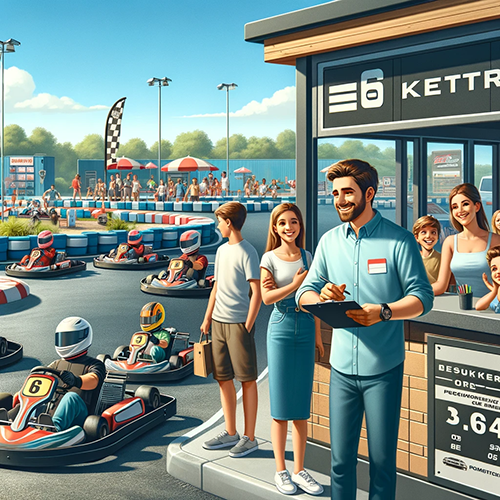 There is a growing demand for facilities that have not returned to pre-covid revenues to seek methods to restore the revenue streams experienced prior to the Pandemic. There are cuntless reasons for a drop in attendance and resulting revenues. The more notable are limited financial capability and lack of keeping up with guest expectations. Today’s guests have greater expectations and more options.
There is a growing demand for facilities that have not returned to pre-covid revenues to seek methods to restore the revenue streams experienced prior to the Pandemic. There are cuntless reasons for a drop in attendance and resulting revenues. The more notable are limited financial capability and lack of keeping up with guest expectations. Today’s guests have greater expectations and more options.
Upgrading kart fleets and track challenges or complete reconstruction with improved geometrics stand at the front of increased attendance generation and increased revisits. For lesser budgets there are still realistic steps that can be used for initial improvements in attendance and revisits.
For many this involve taking a realistic look at previous operations, policies nod equipment. A large percentage of the concession go-kart tracks I visited in the 10 years prior to the pandemic were dropping the ball when it came to potential revenues. These operations included situations that could easily have been corrected.
Today’s solutions may consist of infusion of capital to purchase additional go-karts or for rehabilitation of track components. Other operations indicated a more pressing need for better staff training, more diligent maintenance programs and more creative marketing.
Too Few Karts Available on the Track:
My comments are addressed to those owners and operators committed to profitability. Many of you are missing the boat so to speak. Revenues are generated by karts on the tracks, being driven by your paying guests. They cannot bring in revenue parked in the maintenance building awaiting repairs. By the same token, long lines waiting for karts may be okay if you have reached the track’s capacity, but they are not a good idea if you have more track capacity and aren’t utilizing it. This doesn’t refer to situations where the long lines only occur once in a while and only for an hour or so.
If you regularly experience long lines for several hours on a regular basis, it is time to seriously consider buying more karts, adding a second set of pit lanes and filling them with new karts. By going to a dual pit operation you can increase track capacity by approximately 60% during your peak hours without adding a second track. Single pit operations with 4-minute rides generate approximately 8 turns an hour while dual pitting allows 13 turns an hour.
Bad Mix of Single and Double Karts:
This is an especially telling problem in facilities where there is an imbalance in single karts and double karts. I’ve observed delays in loading due to the mix of guests in the queue lines not being able to efficiently move around people waiting for the two seat karts. Track having this problem should seriously consider obtaining more two-seat karts and crating specific lanes for them and/or creating a separate queue line for two seat riders.
I have witnessed people leaving a pit area without riding because the wait for two seat karts was three times as long. In one instance I left a track with my grandchildren because the track only had four two seat karts in the pits and the older grandchildren were riding two times to one for the younger ones and we were on a travel time schedule. Fortunately the track refunded our unused two ride tickets.
Another solution for this would be to change the track fleet to all two-seat karts (types that are configured to appear as a single seat kart when one rider is in it). This method permits a continuous flow through the pits and guarantees that those riding two to a kart have no longer waiting time than anyone else. We suggest that our clients strongly consider this format and those that instituted it have had nothing but praise for the system.
Too Few Staff Members both, in Pits and on Track:
I’ve personally watched staff members at one track lose two or more turns per hour because they took too long to get people seated and belted properly as a result of only two people working the pit during peak periods. Where is the math? By avoiding employing one more person to assist in the loading and unloading of guests in the pits resulted in the loss of more than $200.00 per hour in revenue. During non-peak times the supplemental pit staff can perform site cleaning or other overhead type operations. Proper scheduling of staff to cover peak days and peak periods can allow keeping the staff to a reasonable level
Reduced runs per hour can easily occur if there are too few staff members on the track to address stalls, untangle spinouts and loading and unloading karts in the pit. The presence of more personnel on the track generates a feeling of confidence and safety in the minds of many parents and guardians while at the same time reducing the temptation to miss-behave on the part of many guests.
Insufficient Staff Training:
Many facilities assign staff members to the go-kart track without sufficient training in how to best assist guests in entering, belting and leaving their karts, giving instructions prior to karts leaving the pits, addressing unruly drivers and related issues both in the pits and on the track.
Hopefully no major accidents or weather related problems occur when lightly trained staff members are in control of your track operations. The go-kart operation should employ your most dependable staff members in order to maximize guest experiences and return visits.
Tolerating Misbehavior on the Track or in the Queue Line:
It’s your facility, your equipment and your guests. Why let the misbehavior of anyone, staff or guest result in reduced safety, damage to equipment or injury to guests or staff? While some idiot guests may feel they paid $5.00 or 5.00 for a license to damage your equipment and disrupt the enjoyment of your facility by others, this is not the case, and you should prohibit such behavior from the beginning. Removing a bad actor or two from your track and facility is one of the best marketing tools you can use. Other guests see that you are committed to operating a safe and entertaining facility, and the good will you generate will result in far more repeat visits than the lost business of the few people you ban from your track.
Faulty Equipment:
Many tracks I’ve visited fail to have a full complement of karts on the track during peak periods. This can result in the loss of $40.00 to more than $50.00 per hour per missing kart on the grid. Some facilities apparently do this on purpose because it makes it easier to operate the track. This is fine if you don’t have to address the bottom line, but doesn’t make sense from a business point of view.
Other problems include poorly tuned karts that have to be restarted, faulty seat belts that require extra time to adjust, poor tire maintenance resulting in flat tires on the track or in the pits and other mechanical problems that could be avoided with basic maintenance procedures.
Failure to maintain the tuning of all the karts can result in large speed differentials among the karts on the track. This can result in sizable guest dissatisfaction with your facility.
Bad Surface Sections on Track:
Almost every track has a point at which more spinouts occur. These have the potential of reducing the number of turns per hour, each of which can result in the loss of $50.00 to $150.00 (depending on the number of karts on the track and the price per ride). When the average track has from 16 to 24 peak hours per week, this is a loss that usually cannot be made up.
Not only does the track generate less revenue, during busy periods it can result in potential customers being turned off because of excessive waits for rides. Some people have set time limits for their visits (maybe because of other commitments, travel distances or other individual reasons). For some people, this can be the reason they don’t return.
Bad pavement surface can result in accidents by causing drivers to lose control, high tire wear and in some instances when track surfaces are in poor repair fragments of pavement can strike guests or staff members.
There are many ways to drive guests from your facility, but you certainly want to minimize the number of instances where it occurs. Don’t let your track operations be the source of lost revenues. Remember! The only guests you can afford to lose forever are those that are unruly.
Failure to Maintain or Repair Faulty Track Elements:
Not all problem areas on a given track can be remedied, but most can. The vast majority of the current concession go-kart tracks in operation are equipped with modern track safety barriers, but not all are being maintained in a safe condition. To bring them back into a safe condition may require redesigning and reconstructing a curve, straightening a section of barrier rail, upgrading track drainage, bad pavement or other relatively minor revision. The cost of accomplishing this may well remedy an ongoing disruption to peak operations and the resulting continual loss in revenue.
Worn, bent and rusty safety barrier rails leave the appearance that management doesn’t care. This may be an image only impact, but it can impact on return visits, which your facility emphatically needs. It is even worse if your track has plastic pipe (Driscoll Pipe), steel plate beam guardrail, timber rails or even worse, loose tires. All of these elements are potential lawsuits waiting to happen. Some of these track barriers still exist despite the fact that Phillips Petroleum, the manufacturer of PVC (Driscoll) pipe sent out a letter in the early 90s asking that the go-kart industry not use the product for track barriers, as it was not suitable for the purpose.
There may even be a few tracks in operation that still use highway steel plate beam guardrail or timbers even though it’s a “no-brainer” to see the hazards of using them. The impacts are very hard on both karts and riders. Several years ago there were still a few tracks using loose tires as their track safety barriers. Loose tires have been the source of a number of fatalities and should never be used.
Conclusions:
Go-karts are one of the most popular outdoor attractions and have proven to be effective “magnet “ attractions as they attract guests from further distances and when the tracks are properly designed have proven to be very effective return visit generators.
Ongoing manufacturer developments in go-kart performance and safety coupled with Track designers continuingly seeking to improve safety, entertainment and excitement in their designs.
Owners and operators that give consideration to the above suggestions have an opportunity to see their revenues increase nod be sustainable.
A realistic step to take if you require more than cleaning up an existing messy, rundown facility, is considering seeing outside expertise. This should include talking to potential industry consultants and possibly selecting one to work with as part of your project team. Hopefully you include our firm, Entertainment Concepts, Inc. (fecdesigners.com) as an option. We will certainly appreciate your consideration.
Peter is a Licensed Professional Engineer in the States of Illinois and Michigan and is President of Entertainment Concepts, Inc. (formerly Peter F. Olesen and Associates, Inc.). He founded the firm in 1984 and expanded its range of consulting services over the years to now provide a wide range of consulting services. Services range from preliminary site evaluations, feasibility studies, business plan assistance, concept development, master planning, design and construction engineering services that apply to new facilities as well as renovation or expansion of existing facilities. Projects include the design of both outdoor and indoor, family entertainment centers, amusement parks, theme parks, stand-alone go-kart tracks and miniature golf courses, bumper boat ponds and related attractions. The firm has been and continues to be at the forefront of go-kart, miniature golf course and bumper boat pond design, introducing many innovations in safety, geometrics, design and construction methods now widely emulated throughout the industry.
To date the firm has completed more than 670 projects spanning 46 states, Angola, Brunei, Canada (Alberta, British Columbia, Ontario, Quebec and Saskatchewan), Cuba (Guantanamo Bay), Kazakhstan, Mexico, Puerto Rico, Saudi Arabia and Vietnam. Since 1987 Mr. Olesen has exhibited at more than 100 industry trade shows. He is a member of the faculty of Foundations Entertainment University (49 seminar presentations over 17 years), presented more than 100 seminar presentations at the International Association of Amusement Parks and Attractions, FunExpo, Kart Expo and Leisure Expo, as well presenting go-kart safety seminars for the State of Ohio. He has, and continues to author articles for industry magazines and internet newsletters. For additional information on projects and services offered please refer to our web page www.fecdesigners.com or contact us at 847-561-7013 or www.peteolesen @yahoo.com.
Copyright: Entertainment Concepts, Inc. 2024

 The pandemic is now a bad memory.
The pandemic is now a bad memory.